Assessing Value Created by IT in Moroccan Healthcare: Perspectives from Professionals †
Abstract
1. Introduction
2. Overview of Moroccan Healthcare and IT Integration
3. Materials and Methods
3.1. Sampling and Participant Selection
3.2. Data Collection Process
3.3. Data Processing and Analysis
- 1.
- Transcription: All interviews were transcribed verbatim to maintain data integrity and facilitate detailed analysis.
- 2.
- Corpus Creation: Transcribed data was organized into a structured corpus, making it ready for analysis using the VOSviewer software v1.6.20.
- 3.
- Textual Analysis: We performed a comprehensive textual analysis using VOSviewer, which allowed us to extract meaningful patterns and themes from the data. We selected VOSviewer software due to its advantages in organizing and analyzing qualitative data. VOSviewer supports the creation of bibliometric maps, assists in clustering and categorizing data, and enhances the analytical process by identifying connections and patterns within large textual corpora [14]. This software facilitated a structured and visual approach to our data analysis, helping us present the findings in a coherent and insightful manner.
- 4.
- Results Categorization: Finally, we categorized the findings based on emergent themes, allowing for organized interpretation and presentation.
4. Results and Discussion
- (a)
- Quality of Care: Providing high-quality care and improving patient wellbeing.
- (b)
- Accessibility and Communication: Enhancing communication and making healthcare more accessible.
- (c)
- Financial Efficiency: Effective management of costs and resources, along with strong performance.
- (d)
- Operational Effectiveness: Efficient operations, continuous service, and optimal use of resources.
- (e)
- Training and Engagement: Continuous training and engaging healthcare staff are important for improving service quality and fostering innovation.
- (f)
- Safety and Transparency: Ensuring patient safety and maintaining transparency.
4.1. Clustering Analysis
- Green Cluster: Focuses on patient satisfaction and the organization of patient care.
- Yellow Cluster: Emphasizes care quality and service provision.
- Orange Cluster: Highlights efficiency and communication within healthcare.
- Red Cluster: Concentrates on clinical quality and patient outcomes.
- Purple Cluster: Deals with resource management, utilization, and governance.
- Blue Cluster: Stresses service availability and accessibility.
- Light Blue Cluster: Focuses on service quality and production.
- Brown Cluster: Centers on the effectiveness of care and the importance of training.
- Light Purple Cluster: Focuses on time management and the monitoring of patient care.
4.2. Discussion
5. Conclusions
Author Contributions
Funding
Institutional Review Board Statement
Informed Consent Statement
Data Availability Statement
Conflicts of Interest
References
- Viegas, I.S. The Role of Information Technology in Improving the Quality of Health Services In Hospitals. J. Soc. Sci. (JoSS) 2024, 3, 1561–1571. [Google Scholar] [CrossRef]
- Zenjari, A.; Wahabi, R.; El Haj, H.A.; Drissi, H. Public hospital performance assessment: Case of Morocco. J. US-China Public Adm. 2012, 9, 494–506. [Google Scholar]
- Akhnif, E.H.; Belmadani, A.; Mataria, A.; Bigdeli, M. UHC in Morocco: A bottom-up estimation of public hospitals’ financing size based on a costing database. Health Econ. Rev. 2024, 14, 25. [Google Scholar] [CrossRef] [PubMed]
- Ouhbi, S.; Idri, A.; Hakmi, R.; Benjelloun, H.; Fernández-Alemán, J.L.; Toval, A. Requirements specification of an e-health solution to improve cardiovascular healthcare services in Morocco. In Proceedings of the 2016 11th International Conference on Intelligent Systems: Theories and Applications (SITA), Mohammedia, Morocco, 19–20 October 2016; IEEE: Piscataway, NJ, USA, 2016; pp. 1–6. [Google Scholar]
- Parks, R.; Wigand, R.T.; Othmani, M.B.; Serhier, Z.; Bouhaddou, O. Electronic health records implementation in Morocco: Challenges of silo efforts and recommendations for improvements. Int. J. Med. Inform. 2019, 129, 430–437. [Google Scholar] [CrossRef] [PubMed]
- Oumlil, R. Acceptance of E-health by healthcare professionals in developing countries: Case of Morocco. In E-Systems for the 21st Century; Apple Academic Press: Burlington, ON, USA, 2019; Volume 267. [Google Scholar]
- C. H. U. des Centres Hospitalo-Universitaires. The hospital performance evaluation process: Case of the University Hospital Center “UHC” in Morocco. Rev. Int. Des Sci. De Gest. 2019, 2, 668–686. [Google Scholar]
- Mahdaoui, M.; Kissani, N. Morocco’s Healthcare System: Achievements, Challenges, and Perspectives. Cureus 2023, 15, e41143. [Google Scholar] [CrossRef]
- El Otmani Dehbi, Z.; Sedrati, H.; Chaqsare, S.; Idrissi Azami, A.; Merzouki, M.; Raji, M.; Rhalem, W.; Al Idrissi, N.; Nejjari, C.; Amzazi, S.; et al. Moroccan digital health response to the COVID-19 crisis. Front. Public Health 2021, 9, 690462. [Google Scholar] [CrossRef]
- Kadiri, A.; Azzouzi, H.; Sefiani, N. How Health Information Technology Improved Patient Care and Treatment During the COVID-19 Pandemic: A Comparison Between International Case Studies and the Moroccan Context. In International Conference on Advanced Intelligent Systems for Sustainable Development; Lecture Notes in Networks and, Systems; Kacprzyk, J., Ezziyyani, M., Balas, V.E., Eds.; Springer Nature: Cham, Switzerland, 2023; Volume 713, pp. 46–57. [Google Scholar] [CrossRef]
- Mokrini, A.E.; Aouam, T. A fuzzy multi-criteria decision analysis approach for risk evaluation in healthcare logistics outsourcing: Case of Morocco. Health Serv. Manag. Res. 2020, 33, 143–155. [Google Scholar] [CrossRef] [PubMed]
- Panfilova, H.; Nemchenko, O.; Simonian, L.; Tsurikova, O.; Bogdan, N. A comparative analysis of the willingness-to-pay indicators for the use of the innovative health technologies in Jordan, Egypt, Morocco, Sudan and Ethiopia. J. Pharm. Sci. Res. 2018, 10, 2097–2101. [Google Scholar]
- Akhnif, E.; Macq, J.; Meessen, B. The place of learning in a universal health coverage health policy process: The case of the RAMED policy in Morocco. Health Res. Policy Syst. 2019, 17, 21. [Google Scholar] [CrossRef] [PubMed]
- Natarajsivam, A.; Sasikala, R. A Review of Text Analytics Using Machine Learning. In Handbook of Research on Opinion Mining and Text Analytics on Literary Works and Social Media; IGI Global: Hershey, PA, USA, 2022; pp. 54–69. [Google Scholar]
- Fakhkhari, H.; Bounabat, B.; Bennani, M.; Bekkali, R. Moroccan Patient-centered Hospital Information System: Global Architecture. In Proceedings of the ArabWIC 6th Annual International Conference Research Track, Rabat, Morocco, 7–9 March 2019; ACM: New York, NY, USA, 2019; pp. 1–6. [Google Scholar] [CrossRef]
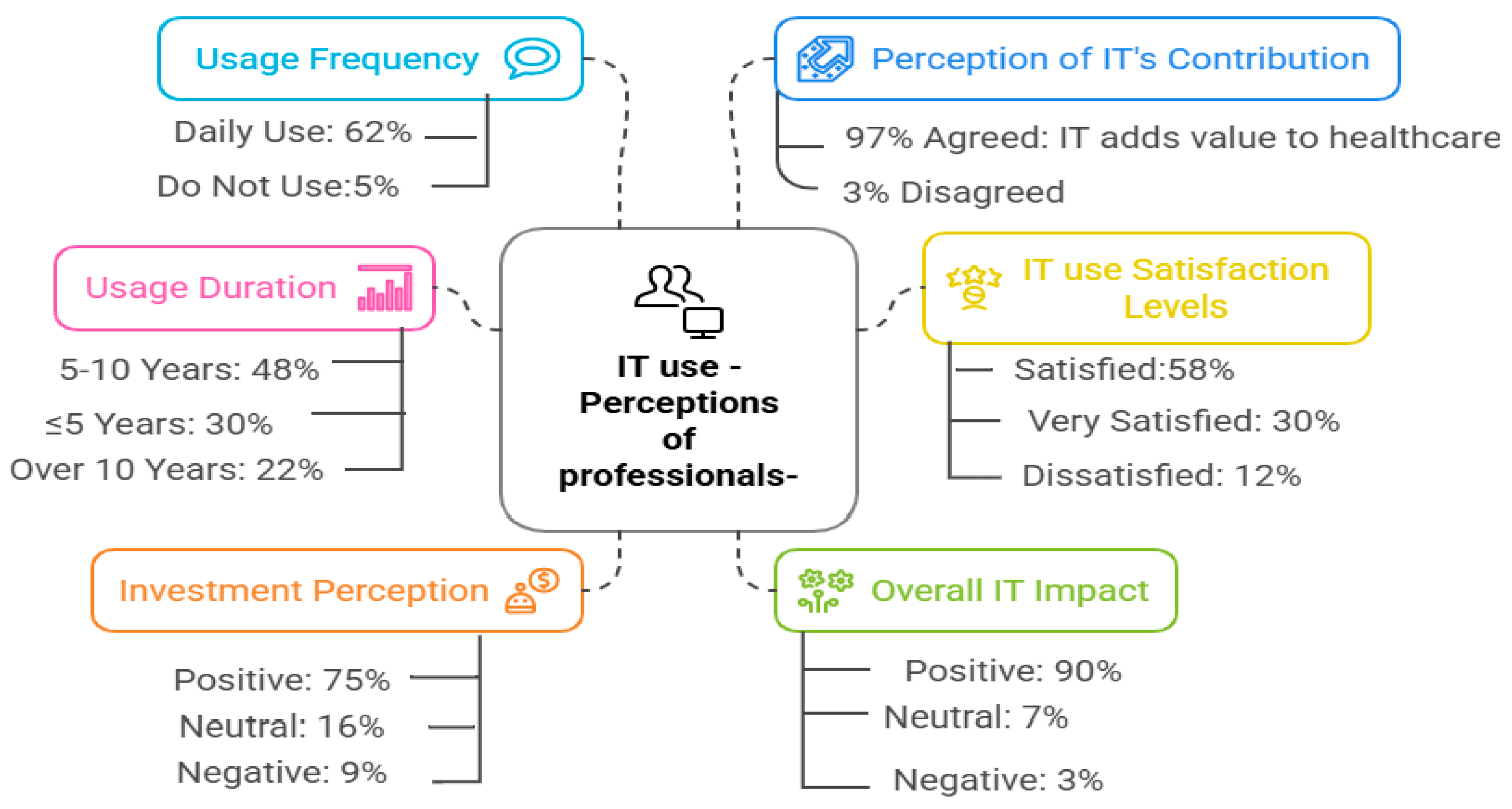
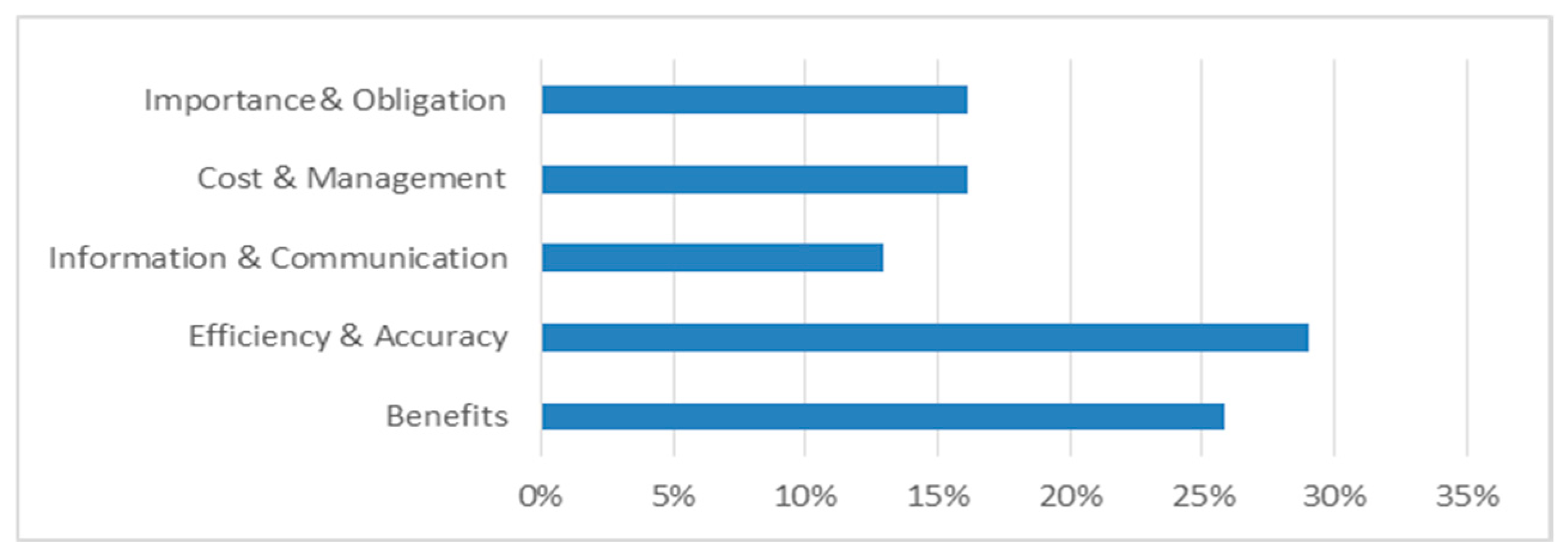
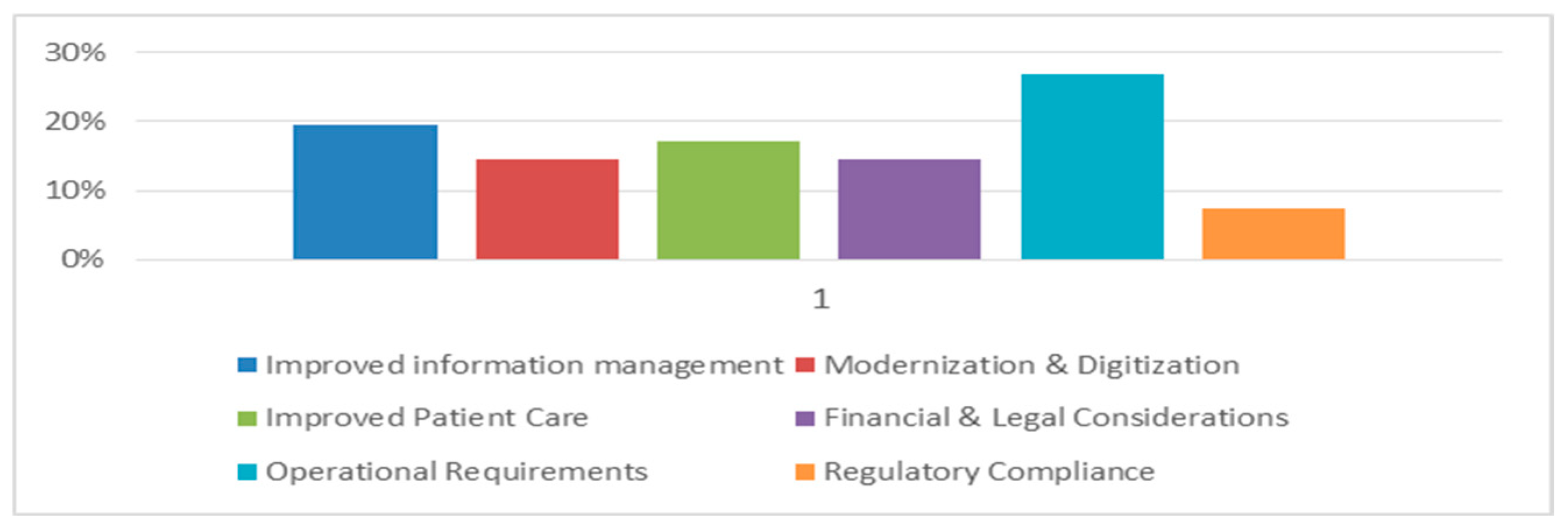
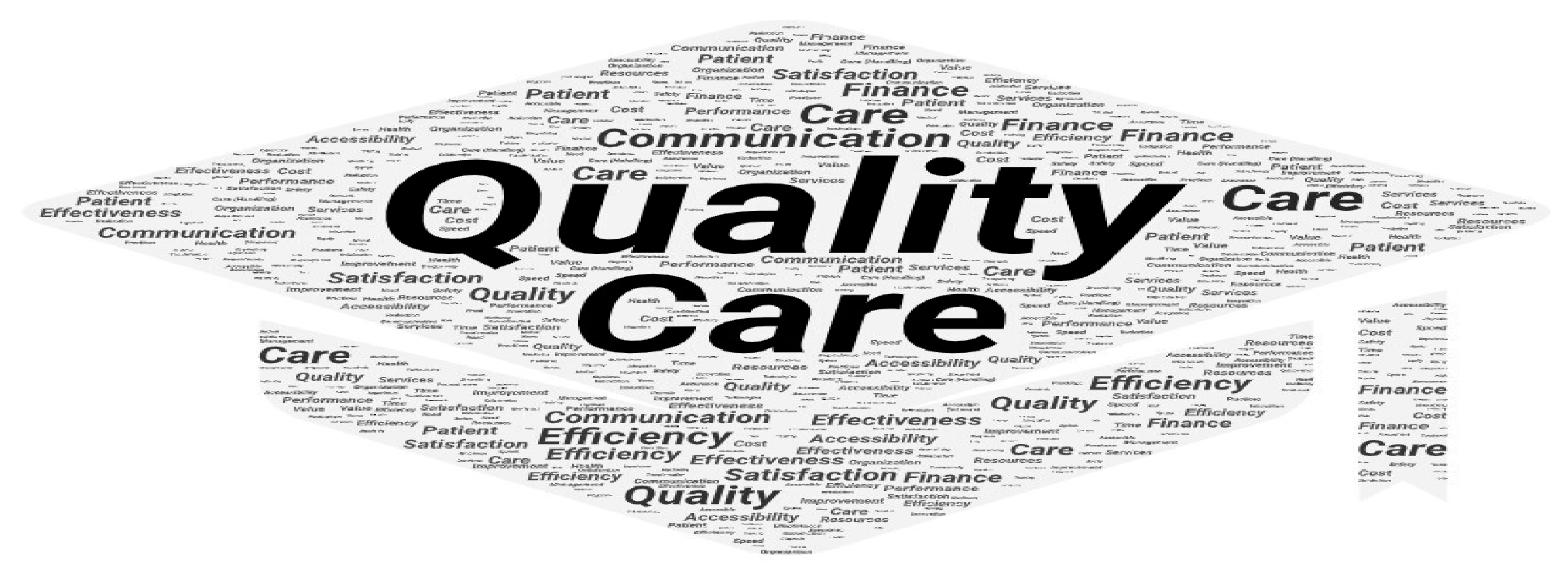
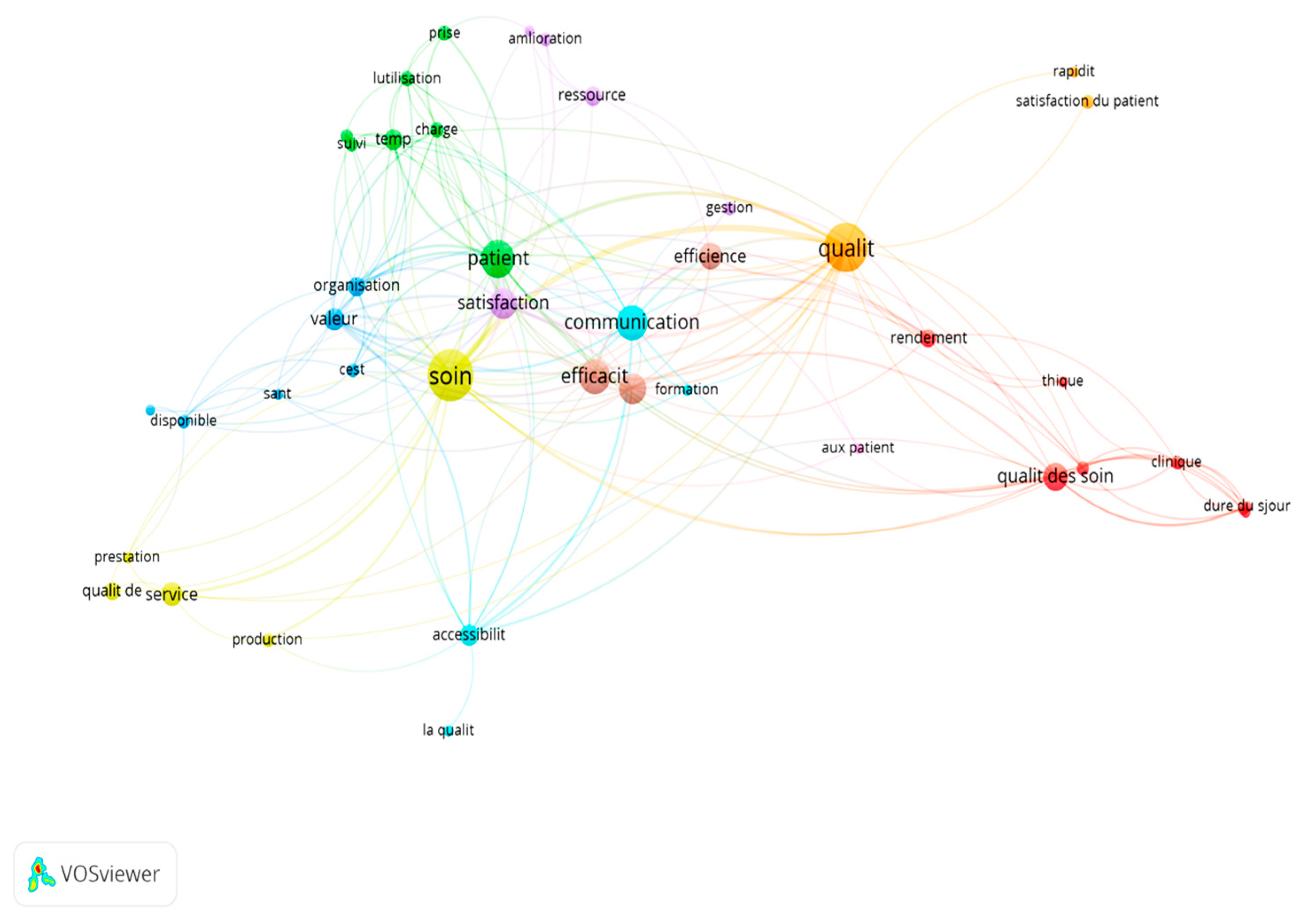
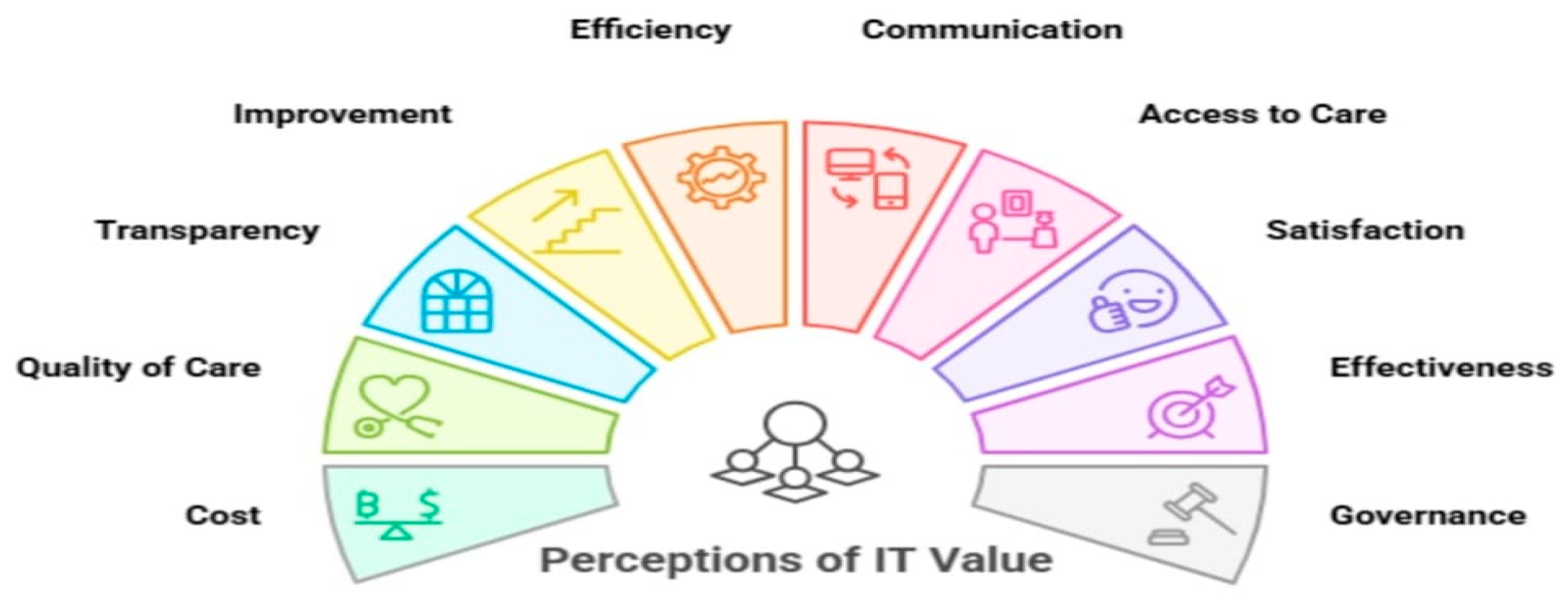
| Steps | Details |
|---|---|
| Appointment Scheduling | Each interview was scheduled in advance to accommodate participants’ availability. |
| Duration | Interviews lasted between 45 min and an hour, providing sufficient time to explore the topics in detail. |
| Interview Mode | Depending on availability and preference, interviews were conducted face-to-face, via telephone, through WhatsApp, or in writing for those who were unable to participate in other formats. |
| Timeline | Data collection was carried between 1 June 2024 and 15 July 2024. |
| Aspect | Details | % |
|---|---|---|
| Gender Distribution | Men | 66% |
| Women | 34% | |
| Age Distribution | 25–50 years | 85% |
| over 50 years | 10% | |
| 18–25 years | 5% | |
| Educational Levels | Bachelor’s +3 | 37% |
| Bachelor’s +5 | 33% | |
| Bachelor’s +7 | 18% | |
| Beyond +7 | 10% | |
| Bachelor’s +2 | 2% | |
| Professional Experience | Over 10 years | 54% |
| 5–10 years | 31% | |
| less than 5 years | 15% | |
| Employment Sector | Public | 85% |
| Private | 15% | |
| Occupations | Nurses | 34% |
| Physicians | 13% | |
| Administrators | 10% | |
| Pharmacists | 1% | |
| Medico-social assistants | 1% | |
| Specialties | Polyvalent nurses | 22% |
| Anesthesia–reanimation specialists | 9% | |
| General physicians | 6% | |
| Midwives | 6% | |
| Statistical technicians | 1% | |
| Traumatologists | 1% | |
| Workplace Settings | Hospitals | 43% |
| Clinics | 12% | |
| University Hospital Centers | 9% | |
| Health Centers | 7% | |
| Military Hospitals | 1% | |
| Regional Health Directorates | 1% |
Disclaimer/Publisher’s Note: The statements, opinions and data contained in all publications are solely those of the individual author(s) and contributor(s) and not of MDPI and/or the editor(s). MDPI and/or the editor(s) disclaim responsibility for any injury to people or property resulting from any ideas, methods, instructions or products referred to in the content. |
© 2025 by the authors. Licensee MDPI, Basel, Switzerland. This article is an open access article distributed under the terms and conditions of the Creative Commons Attribution (CC BY) license (https://creativecommons.org/licenses/by/4.0/).
Share and Cite
Oumlil, R.; Makhoukh, F. Assessing Value Created by IT in Moroccan Healthcare: Perspectives from Professionals. Eng. Proc. 2025, 112, 36. https://doi.org/10.3390/engproc2025112036
Oumlil R, Makhoukh F. Assessing Value Created by IT in Moroccan Healthcare: Perspectives from Professionals. Engineering Proceedings. 2025; 112(1):36. https://doi.org/10.3390/engproc2025112036
Chicago/Turabian StyleOumlil, Rachid, and Fatima Makhoukh. 2025. "Assessing Value Created by IT in Moroccan Healthcare: Perspectives from Professionals" Engineering Proceedings 112, no. 1: 36. https://doi.org/10.3390/engproc2025112036
APA StyleOumlil, R., & Makhoukh, F. (2025). Assessing Value Created by IT in Moroccan Healthcare: Perspectives from Professionals. Engineering Proceedings, 112(1), 36. https://doi.org/10.3390/engproc2025112036





